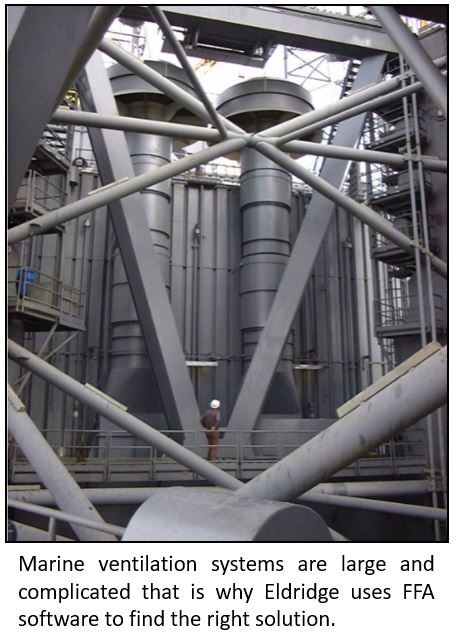A well-designed marine ventilation system is crucial for any vessel. It serves two main purposes. First, it brings in fresh air to make breathing easier and control moisture. This helps prevent mold and rust, cutting down on maintenance. Second, it moves out hot air to keep machines running well and crew members comfortable in closed spaces, boosting their productivity. We often hear from vessel owners who find their ventilation systems aren’t meeting these needs. In this blog, I’ll explain how Eldridge fixes marine ventilation system problems.
Complicated Systems
The main reason marine ventilation systems often fail is due to wrong estimates of system static pressure. This happens a lot because these systems are complicated. Workspaces below deck need to be watertight and protected from fire or blast risks. So, marine ventilation systems use supply and exhaust fans with special dampers, louvers, silencers and filters.
Add to this the limited space for ducts, which may mean combining supply or exhaust lines for several areas. Some systems also have both supply and exhaust fans working together and against each other. With all these moving parts, it’s easy to see why static pressure calculations can go wrong.

Fixing Problems the Right Way
We’ve seen vessel owners try to fix ventilation issues by using bigger fans or adding more dampers to balance airflow. These fixes cost a lot and can limit airflow, pushing fan motors too hard or causing fans to stall. Both problems can make the whole system break down, leading to vessel downtime and safety risks.
The only proper way to redesign marine ventilation systems is through fluid flow analysis (FFA). Eldridge uses proprietary FFA software to analyze pressure drops and airflows in detail. What makes our FFA software stand out is that we can program real fan curves into it. This lets us pick the right fans to solve existing ventilation problems.
Acoustics Matter
Another major failure for most marine ventilation systems is their sound level. When a marine ventilation system exceeds its noise specification, this can create safety issues if crew members aren’t able to communicate. The leading cause of acoustic design failure is not understanding how noise is amplified by reflective surfaces and how it combines with other noise sources.
Like our proprietary FFA software, we have a proprietary process for analyzing acoustics. It starts with a detailed understanding of the noise source, its location and the paths that its sound will travel. Then we calculate how the source noise is impacted by its surroundings which includes other noise sources. Finally, we determine the size, configuration and location of noise control devices that will reduce the source noise to an acceptable level.
Conclusion
If your vessel has poorly designed airflow and acoustics, Eldridge can help. Our marine ventilation specialists have the expertise and experience to redesign your marine ventilation system for safe, efficient and quiet vessel operations.
